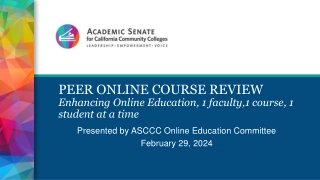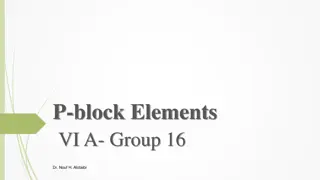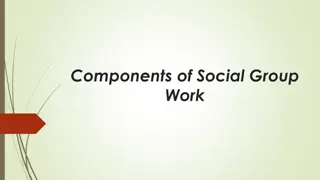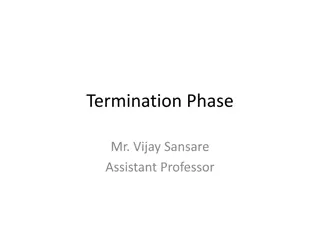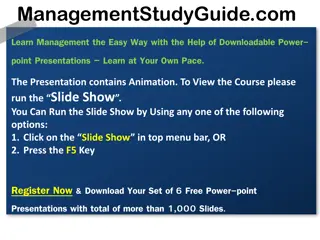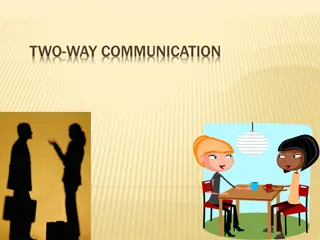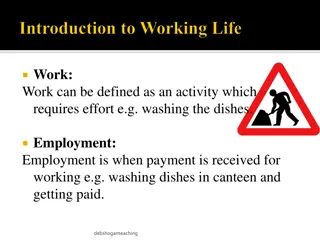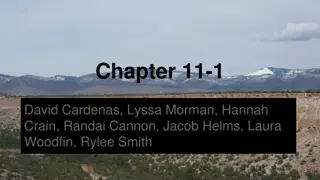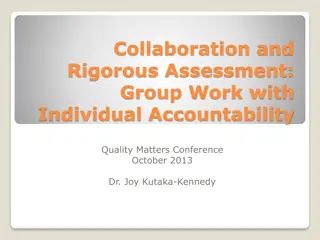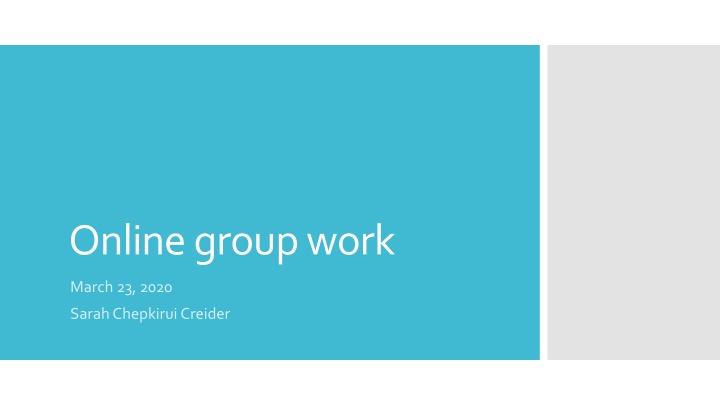
Enhancing Online Group Work for Student Engagement and Interaction
Explore the dynamics of online group work in education, focusing on enhancing student engagement and interaction through small group activities. Key points include creating a sense of community, structuring group tasks effectively, and assigning roles for collaboration. Discover insights on teaching methods classes online and computer-supported collaborative learning for research purposes.
Download Presentation

Please find below an Image/Link to download the presentation.
The content on the website is provided AS IS for your information and personal use only. It may not be sold, licensed, or shared on other websites without obtaining consent from the author. If you encounter any issues during the download, it is possible that the publisher has removed the file from their server.
You are allowed to download the files provided on this website for personal or commercial use, subject to the condition that they are used lawfully. All files are the property of their respective owners.
The content on the website is provided AS IS for your information and personal use only. It may not be sold, licensed, or shared on other websites without obtaining consent from the author.
E N D
Presentation Transcript
Online group work March 23, 2020 Sarah ChepkiruiCreider
1. Please use video if you possibly can. (And, if you can t, we understand!) 2. Please mute your microphone unless you are talking. 3. You do not need to use the raise hand icon to speak just talk when you want to! 4. I appreciatebeing interrupted! I ll tell you if I need to move on. Our online setting Any other technological concerns?
Research focus is teacher-student interaction and student engagement Background in working with language learners Background Thus many reasons for using small group work
1. Creating connection and community 2. Student engagement 3. How to teach methods classes In an online setting: my initial concerns Thus: Online group work For your own research: Computer supported collaborative learning (CSCL)
1. Two layers Content Collaboration 2. Students need to learn how to do it 3. Planning and structure are key Group work
Content: What will students actually be doing? Collaboration How will they work together? Content and Collaboration
Group size: 3 or 4 is ideal Synchronous or asynchronous? The importance of giving roles. Collaboration Basic roles: Leader/boss Time keeper Participation monitor Note-taker/Reporter Questioner What else?
Group Discussion #1 Leader s name: Participation monitor s name: Note-taker/presenter s name: 1. Have you had experiences with cross-cultural differences in genre expectations? Example 2. What are your questions about teaching genres? 3 Were you taught writing using the concept of genres? Was this helpful for you?
II. Reflections 1. The assignment for the attached documents was to write a 1-to 3-paragraph reflection on a reading about culture shock. Each person in your group should answer two of the following questions. The other members are required to comment on these answers. For example: Person A answers questions 1 and 2 Person B answers questions 3 and 4 Person C answers questions 5 and 6 Example: structures vs roles Person A comments on the answers to questions 3, 4, 5, & 6 Person B comments on the answer to questions 1, 2, 5, & 6 Person C comments on the answers to questions 1, 2, 3, & 4 1. Do you have any questions about these reflections? 2. What is their purpose? (What action are they trying to accomplish?) 3. Who is the intended audience? 4. What is the subject matter? 5. What can you say about tone and formality? 6. Is there a structure or form that these essays have in common?
Multiple modes, multiple times Short videos Written instructions Instructions within documents Giving instructions Checking in, especially at first
Teacher sets them up ahead of time Google Docs Students are told exactly which parts they are responsible for Ability to see who did what (be transparent about this)
Clarity about grading and responsibilities Giving feedback Try to give group or class feedback, rather than individual feedback
Groups of 3 or 4 students Each student produces a power point: 3 slides + 3 minutes of narration Then, each student posts a 50 word response to the other group members The teacher responds to the group as a whole 3x3s Expect technical glitches at first Much deeper thinking than discussion boards Tom Liam Lynch
Blogs Wikis Small group discussions What else? Other tools
Questions and thoughts?

